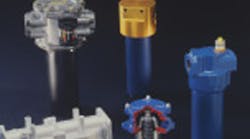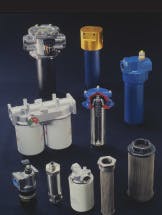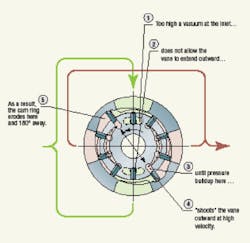With this in mind, let us consider the pros and cons of the various hydraulic filter locations:
Pressure filtration
Locating filters in pressure lines provides maximum protection for components located immediately downstream. Filtration ratings of 2 μm or less are possible, due to the pressure that is available to force fluid through the media. However, filter efficiency can be reduced by high flow velocities and pressure and flow transients, which can disturb trapped particles. The major disadvantage of pressure filtration is economic. Because the housings and elements must be designed to withstand peak system pressure (high-collapse type), pressure filtration has the highest initial and ongoing cost.
Return filtration
The rationale for locating filters in the return line is this: if the reservoir and the fluid it contains start out clean, and all air entering the reservoir and returning fluid is adequately filtered, then fluid cleanliness will be maintained. The other advantage of the return line as a filter location is that sufficient pressure is available to force fluid through fine media (typically 10 μm), but pressure is not high enough to complicate filter or housing design. This, combined with relatively low flow velocity, means that high filtration efficiency can be achieved economically.
For these reasons, return filtration can be beneficial for most hydraulic systems. The main disadvantage of return line filtration is that the backpressure created by the element can adversely affect the operation of or even damage some components.
Off-line filtration
Off-line filtration enables continuous, multi-pass filtration at a controlled flow velocity and pressure drop, which results in high filtration efficiency. Filtration of 2 μm or less is possible, and polymeric (water absorbent) filters and heat exchangers can be included in the circuit for total fluid conditioning. The main disadvantage of off-line filtration is its high initial cost, although this can usually be justified on a life-of-machine cost basis.
Suction filtration
From a filtration perspective, the pump intake is an ideal location for filtering media. Filter efficiency is increased by the absence of both high fluid velocity, which can disturb trapped particles, and high pressure drop across the element, which could otherwise force migration of particles through the media. These advantages are outweighed by the restriction the element creates in the intake line and the negative effect this can have on pump life.
A restriction at the pump inlet can cause cavitation erosion and mechanical damage. And although cavitation erosion contaminates the hydraulic fluid and damages critical surfaces, the mechanical effect of vacuum-induced forces has a more detrimental impact on pump life.
The detriments of vacuum
Development of a vacuum in the pumping chambers of an axial-piston pump puts the piston ball and slipper pad socket in tension. This joint is not designed to withstand high tensile force. Consequently, the slipper becomes detached from the piston, Figure 1. This can occur either instantaneously — if the vacuum-induced tensile force is significant enough — or over many hours of service as the ball joint repeatedly alternates between tension and compression.
The piston retaining plate’s primary function is to keep the piston slippers in contact with the pump’s swashplate, so it must resist the force that acts to separate the piston from its slipper. The vacuum-induced acceleration accelerates wear between the slipper and retaining plate and can cause the retaining plate to buckle. This allows the slipper to lose contact with the swashplate. It is then hammered back onto the swashplate when pressurized fluid acts on the end of the piston. The impact damages the piston slippers and swashplate, leading to rapid catastrophic failure.
The piston is better able to withstand vacuum-induced tensile forces in bent-axis pumps. Piston construction usually is more rugged, and the piston ball is usually held in its shaft socket by a bolted retaining plate. However, tensile failure of the piston stem and/or buckling of the retaining plate can still occur under high vacuum.
In vane pumps, the vanes must extend from their retracted position in the rotor during inlet. As this happens, fluid from the pump inlet fills the void in the rotor created by the extending vane. If high vacuum exists at the pump inlet, it will act at the base of the vane. This causes the vanes to lose contact with the cam ring, and they are then hammered back onto the cam ring as pressurized fluid acts on the base of the vane. The impact damages the vane tips and cam ring, leading rapidly to catastrophic failure, Figure 2.
Gear pumps are mechanically the least susceptible to vacuum-induced forces. Despite this fact, research has shown that a restricted intake can reduce the service life of an external gear pump by at least 50%*.
Issues with suction filters
Suction filters usually take the form of a 150-μm (100-mesh) strainer, which is screwed onto the pump intake inside the reservoir. In the 10 years I’ve actively campaigned against their use — for the reasons outlined above — I’m sure I’ve heard all the counter arguments. However, most arguments in favor of using suction strainers are premised on bad design, bad maintenance, or a combination of both.
The argument that suction strainers are needed to protect the pump from debris that enters the reservoir as a result of poor maintenance practices is a popular one. Nuts, bolts, tools, and similar debris pose minimal threat to the pump in a properly designed reservoir, where the pump intake is located a minimum of 4 in. off the bottom.
When anecdotal evidence is presented that trash — which entered the tank through careless maintenance — did cause a pump failure, its weight is diminished on the basis that, had a suction strainer been fitted, the same neglect of its maintenance would have eventually resulted in the same outcome — premature pump failure. Notwithstanding the above, the correct solution to this problem is to take action to prevent contaminants from entering the reservoir in the first place.
A similar argument asserts that suction strainers are needed to prevent cross contamination where two or more pumps share a common inlet manifold. Here again, if suction strainers are necessary in this situation, then it is only due to bad design: the manifold must be below the pumps’ intakes.
If properly designed, a head of oil will exist above the inlet manifold, and the inlet manifold will be above the pumps’ intakes. For cross contamination to occur in this configuration, debris would have to travel uphill — against gravity and a positive head of oil, which is highly unlikely. But even in situations where a suction strainer is mandated — for whatever reason, the problem is: the cure may be worse than the disease!
Brendan Casey is president and founder of Hydraulic Supermarket and has more than 20 years of experience in the maintenance, repair, and overhaul of mobile and industrial hydraulic equipment. For more information on reducing the operating cost and increasing the uptime of hydraulic equipment, visit www.hydraulicsupermarket.com.
*Ingvast, H., “Diagnosing Tyrone Gear Pump Failures,” The Third Scandinavian International Conference On Fluid Power, Vol. 2, 1993, pp 535-546.




